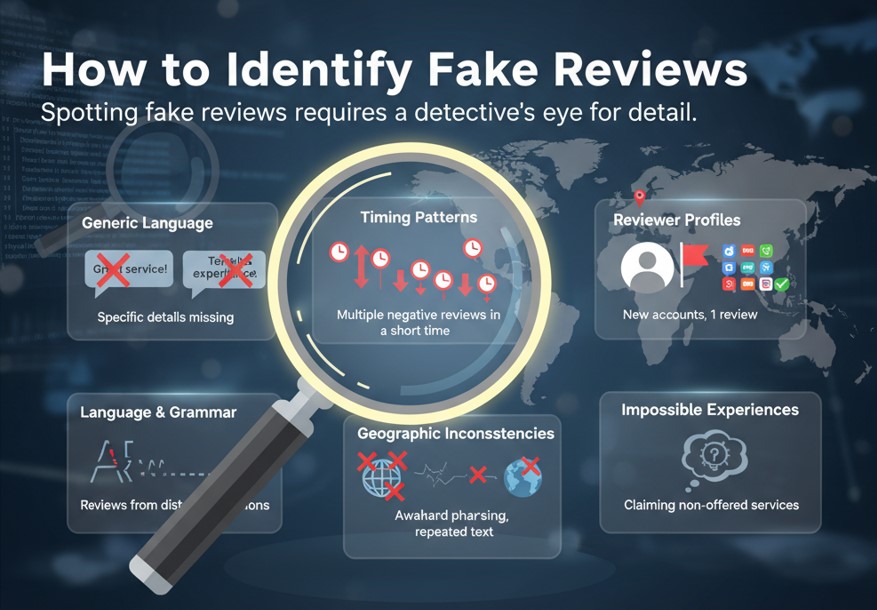Fake reviews can destroy your business reputation overnight. When potential customers see negative feedback that isn’t genuine, they’re likely to choose your competitors instead. If you’ve discovered fraudulent reviews targeting your business on Google, you’re not alone—and more importantly, you can fight back.
Google receives millions of review reports each month, and while its automated systems catch many fake reviews, some still slip through. The good news? Google provides several tools and processes to help legitimate business owners remove fraudulent reviews and protect their online reputation.
This comprehensive guide will walk you through every step of the fake review removal process. You’ll learn how to identify fake reviews, understand Google’s policies, navigate the reporting system, and implement strategies to prevent future fake reviews from damaging your business.
Understanding Google’s Review Policies
Before diving into removal strategies, you need to understand what Google considers a policy violation. Google’s review policies prohibit several types of content that could apply to fake reviews.
Spam and fake content top the list of prohibited review types. This includes reviews that don’t reflect genuine experiences with your business, reviews posted by competitors, or reviews created by services that sell fake feedback.
Off-topic reviews that don’t relate to your actual business offerings also violate Google’s policies. If someone reviews your restaurant but talks about political opinions or unrelated services, this content can be flagged for removal.
Restricted content includes reviews with hate speech, inappropriate language, or personal attacks that go beyond commenting on business performance. Reviews containing personal information about staff members or other customers also fall into this category.
Conflict of interest reviews are another major violation. This includes reviews from current or former employees who don’t disclose their relationship to the business, reviews from competitors, or reviews incentivized through payments or discounts.
Impersonation occurs when someone pretends to be a customer they’re not, or when they create multiple fake accounts to leave multiple reviews.
Understanding these categories helps you build stronger cases when reporting reviews to Google’s support team.
How to Identify Fake Reviews

Spotting fake reviews requires a detective’s eye for detail. Several red flags can help you identify reviews that don’t represent genuine customer experiences.
Generic language often signals fake content. Authentic reviews typically include specific details about the customer’s experience, while fake reviews tend to use vague phrases like “great service” or “terrible experience” without explaining why.
Timing patterns can reveal coordinated attacks. Multiple negative reviews posted within hours or days of each other, especially from new Google accounts, suggest artificial activity.
Reviewer profiles provide valuable clues about authenticity. Check if the reviewer has a complete profile with a real photo, multiple reviews across different businesses, and a history of Google account activity. Brand new accounts with only one review targeting your business raise immediate red flags.
Geographic inconsistencies help identify fake reviews. If your local business receives reviews from accounts located in different countries or distant cities where you don’t operate, these reviews likely violate Google’s policies.
Language and grammar patterns can expose fake reviews, especially those created by review farms or automated systems. Look for awkward phrasing, repeated sentence structures across multiple reviews, or language that doesn’t match your typical customer demographic.
Impossible experiences represent the most obvious fake reviews. These include reviews claiming services you don’t offer, describing locations or features that don’t exist at your business, or detailing interactions that couldn’t have happened based on your business hours or operations.
Step-by-Step Guide to Flagging Reviews
Google provides multiple pathways for reporting fake reviews, and choosing the right method can impact your success rate.
Method 1: Flag directly from Google My Business
Start by logging into your Google My Business account and navigating to the “Reviews” section. Locate the fake review and click the three-dot menu next to it. Select “Flag as inappropriate” and choose the most relevant violation category from the dropdown menu.
When selecting violation categories, be specific. Choose “Fake review” for obviously fraudulent content, “Spam” for promotional content or off-topic reviews, and “Hate speech or profanity” for reviews containing inappropriate language.
Method 2: Report through Google Maps
Open Google Maps and search for your business. Find the fake review in the reviews section and click the three-dot menu. Select “Flag as inappropriate” and follow the same categorization process as above.
Method 3: Use the Google My Business Help Center
For complex cases or when you need to provide additional context, use the Google My Business Help Center’s contact form. This method allows you to explain why a review violates policies and provide supporting evidence.
Best practices for flagging reviews:
Document everything before flagging reviews. Take screenshots of the fake reviews, the reviewer’s profile, and any evidence supporting your claim. This documentation proves valuable if you need to escalate your case.
Be patient but persistent. Google typically reviews flagged content within 3-5 business days, though complex cases may take longer. If a review isn’t removed after the initial flag, try reporting it through a different method or escalating to Google Support.
Focus on policy violations rather than emotional responses. When explaining why a review should be removed, cite specific policy violations rather than arguing about fairness or impact on your business.
Appealing Rejected Removal Requests
Sometimes Google’s initial review process doesn’t result in fake review removal, even when violations seem clear. The appeals process provides a second chance to make your case.
Understanding why removal requests get rejected:
Google errs on the side of keeping reviews published to maintain the integrity of the review ecosystem. Their automated systems and human reviewers apply strict standards, sometimes keeping borderline cases that business owners believe should be removed.
How to file an appeal:
Access the Google My Business Help Center and look for the “Contact Support” option. Select “Reviews and photos” as your issue category, then “Report a policy violation” as your specific problem.
When filing appeals, provide new evidence or arguments that weren’t included in your initial filing. Explain specific policy violations using Google’s exact language from their review policies. Include relevant screenshots, business records, or other documentation that supports your case.
Escalating to Google Support:
For persistent fake review problems, consider requesting a phone consultation with Google My Business support. These conversations allow you to explain complex situations and get personalized guidance on review removal strategies.
Social media escalation sometimes proves effective for businesses facing coordinated fake review attacks. Publicly documenting your situation on Twitter or LinkedIn while tagging Google’s business accounts can bring additional attention to legitimate cases.
Advanced Strategies for Persistent Issues
When standard reporting methods don’t resolve fake review problems, several advanced strategies can help protect your business reputation.
Legal considerations:
Document fake reviews and their impact on your business. In cases involving competitor harassment, review bombing, or clear defamation, consult with an attorney specializing in business law or online reputation management.
Some fake review creators violate state or federal laws, particularly when reviews contain false statements of fact that damage your business. Legal action can sometimes compel review platforms to remove content or provide information about review creators.
Working with reputation management professionals:
Professional reputation management services have established relationships with Google and other review platforms. They understand the nuances of platform policies and can often achieve better results than individual business owners.
These services also provide ongoing monitoring and response strategies that help prevent future fake review attacks while building genuine positive review volume.
Building a defense strategy:
The best defense against fake reviews is a strong foundation of authentic positive reviews. Implement systematic approaches to encourage satisfied customers to leave genuine reviews on Google.
Create review generation campaigns that make it easy for happy customers to share their experiences. Use email follow-ups, QR codes on receipts, or staff training to increase legitimate review volume.
Monitor your online reviews regularly using Google Alerts, review monitoring tools, or reputation management software. Quick identification and response to fake reviews improves your chances of successful removal.
Preventing Future Fake Reviews
Proactive prevention strategies reduce your vulnerability to fake review attacks and build long-term reputation resilience.
Monitor competitor activity:
Keep track of your competitors’ review patterns and reputation management strategies. Unusual spikes in their positive reviews or coordinated attacks against multiple businesses in your industry may signal fake review activity that could target you next.
Strengthen your authentic review foundation:
Focus energy on generating legitimate positive reviews from real customers. The stronger your base of authentic reviews, the less impact fake reviews will have on your overall rating and reputation.
Train your team to provide exceptional customer service that naturally leads to positive reviews. Happy customers become your best advocates and review generators.
Implement review monitoring systems:
Set up Google Alerts for your business name and monitor your Google My Business listing regularly. Quick identification of fake reviews improves removal success rates and minimizes reputation damage.
Use reputation monitoring tools that track reviews across multiple platforms and send immediate notifications when new reviews are posted.
Taking Action to Protect Your Business
Fake reviews represent a serious threat to your business reputation, but you’re not powerless against them. Google provides clear policies and removal processes that work when you understand how to use them effectively.
Start by auditing your current Google reviews for potential policy violations. Document any suspicious reviews using the identification criteria outlined above, then systematically report them through Google’s official channels.
Remember that building a strong foundation of authentic positive reviews provides the best long-term protection against fake review attacks. Focus equal energy on generating genuine customer feedback while fighting fraudulent content.
Stay persistent but professional throughout the removal process. Google’s systems are designed to protect review integrity, which sometimes means legitimate removal requests require multiple attempts or appeals. Your business reputation is worth the effort required to maintain it properly.
In addition to removing fake feedback, it’s equally important to manage negative reviews—whether they’re fake or real. Responding professionally, addressing customer concerns, and showing transparency builds trust with potential customers who read your responses. A well-managed response strategy can turn even negative reviews into opportunities to showcase your business’s commitment to service.
Learn more about: How to Remove Negative Content from the Internet





